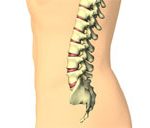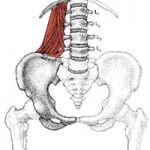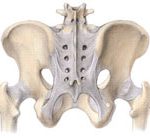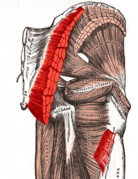 Structurally, the low back is the lumbar spine (five vertebrae) and the sacrum (the triangular bone at the base of your spine below the waist) with the coccyx (tail bone) at the tip. The lumbar spine is curved to make an arch in the small of your back. It is built to support weight. The vertebrae are chunky and wedge-shaped and stack up in a curve. In architecture, the strongest form is an arch. Your body needs this strong curve to hold up the weight of the upper body (torso). When you bend forward, the front edge of these wedges come together and the back edge opens up, stretching all of the muscles that cross the individual vertebral joints and those that span the total curve of the lumbar spine. When you load these muscles (adding weight) in a stretched position, it can make them spasm if they are unable to support the weight of the torso with the added weight of the object. Sometimes the weight of the torso alone is too much.
Structurally, the low back is the lumbar spine (five vertebrae) and the sacrum (the triangular bone at the base of your spine below the waist) with the coccyx (tail bone) at the tip. The lumbar spine is curved to make an arch in the small of your back. It is built to support weight. The vertebrae are chunky and wedge-shaped and stack up in a curve. In architecture, the strongest form is an arch. Your body needs this strong curve to hold up the weight of the upper body (torso). When you bend forward, the front edge of these wedges come together and the back edge opens up, stretching all of the muscles that cross the individual vertebral joints and those that span the total curve of the lumbar spine. When you load these muscles (adding weight) in a stretched position, it can make them spasm if they are unable to support the weight of the torso with the added weight of the object. Sometimes the weight of the torso alone is too much.
 The importance of the quadratus lumborum: The QL attaches all of the lumbar vertebrae and the disc spaces between them to the hip bone below and the lowest rib above. It functions mostly to stabilize the lumbar spine and is working all the time that your body is upright. It also acts as a side-bending, hip-hiking muscle and as a back extensor (bending backwards). When you bend forward, the muscle stretches across the lumbar curve and tightens to support the weight. If the muscle isn’t healthy enough to do the work it will seize up and cause unmanageable pain. Trigger Points harbored in this important but tiny muscle are the most frequent cause of low back pain complaints.
The importance of the quadratus lumborum: The QL attaches all of the lumbar vertebrae and the disc spaces between them to the hip bone below and the lowest rib above. It functions mostly to stabilize the lumbar spine and is working all the time that your body is upright. It also acts as a side-bending, hip-hiking muscle and as a back extensor (bending backwards). When you bend forward, the muscle stretches across the lumbar curve and tightens to support the weight. If the muscle isn’t healthy enough to do the work it will seize up and cause unmanageable pain. Trigger Points harbored in this important but tiny muscle are the most frequent cause of low back pain complaints.
How does the side-body get involved?
 Latissimus dorsi: You know at the gym when you do “lat pull-downs?” That action is similar to what you do when reach out and bring a heavy object toward your body. The latissimus dorsi muscle (from the Latin meaning the widest on the back) moves the upper arm, starting underneath it up near your armpit (axilla) and spanning the space diagonally, attaching to the lowest ribs, forming that desirable V-shape men work for. It then swings around under the shoulder blade arranged like a fan whose edges attach all the way from the lower thoracic spine (where ribs attach) to all of the lumbar vertebrae, down to the top of the back of the hip bone (iliac crest) at the base of the spine. Pain from Trigger Points in this muscle refers into to the side and back at the waist.
Latissimus dorsi: You know at the gym when you do “lat pull-downs?” That action is similar to what you do when reach out and bring a heavy object toward your body. The latissimus dorsi muscle (from the Latin meaning the widest on the back) moves the upper arm, starting underneath it up near your armpit (axilla) and spanning the space diagonally, attaching to the lowest ribs, forming that desirable V-shape men work for. It then swings around under the shoulder blade arranged like a fan whose edges attach all the way from the lower thoracic spine (where ribs attach) to all of the lumbar vertebrae, down to the top of the back of the hip bone (iliac crest) at the base of the spine. Pain from Trigger Points in this muscle refers into to the side and back at the waist.
 Intercostals: There are three layers of muscles between each rib. Think of all the meat you enjoy when you eat spare ribs. They are involved with breathing and with compressing the rib cage during rotation and somewhat with side-bending. Trigger Points are mostly localized. When lifting something heavy, the exertion usually requires compression of the ribs to hold the breath. Forced exhalation contracts these muscles.
Intercostals: There are three layers of muscles between each rib. Think of all the meat you enjoy when you eat spare ribs. They are involved with breathing and with compressing the rib cage during rotation and somewhat with side-bending. Trigger Points are mostly localized. When lifting something heavy, the exertion usually requires compression of the ribs to hold the breath. Forced exhalation contracts these muscles.
What muscles and ligaments support and move the lowest part of the spine?
 Erector spinae: These are the two groups of muscles that run along beside the spine from top to bottom that keep you erect. You may feel these muscles pull when you lower your head. They work like a snake, moving the whole spine as a unit or the individual parts. One set ends at the lumbar spine and the other at the sacrum. Pain from Trigger Points in these muscles refer up the back and down into the buttock and top of the hip bone.
Erector spinae: These are the two groups of muscles that run along beside the spine from top to bottom that keep you erect. You may feel these muscles pull when you lower your head. They work like a snake, moving the whole spine as a unit or the individual parts. One set ends at the lumbar spine and the other at the sacrum. Pain from Trigger Points in these muscles refer up the back and down into the buttock and top of the hip bone.
Multifidi and rotatores: These little muscles are nestled in the deep groove of the spine on either side of the spinous processes that you see as the bony bumps down the back. The multifidi (from the Latin meaning split into many parts) perform a combination of rotation and extension (arching) of the individual vertebrae. There is a thick pad of them right where the lowest vertebra meets the sacrum. The rotatores are smaller and deeper. Their only job is to rotate the vertebrae. Pain referred from Trigger Points in these muscles is very localized at the spine and sacrum.
 Iliolumbar ligament and sacroiliac ligaments: Ligaments connect bone to bone. The iliolumbar ligament connects the ilium (hip bone) to the lowest lumbar vertebra. The sacroiliac ligament connects the sacrum to the ilium. They provide strong support with just a little give. If they stiffen up, as they can when a muscle is overstretched, they can compress the joints they cross and make the nerves in the joint fire, causing pain. (neurosoma.com)
Iliolumbar ligament and sacroiliac ligaments: Ligaments connect bone to bone. The iliolumbar ligament connects the ilium (hip bone) to the lowest lumbar vertebra. The sacroiliac ligament connects the sacrum to the ilium. They provide strong support with just a little give. If they stiffen up, as they can when a muscle is overstretched, they can compress the joints they cross and make the nerves in the joint fire, causing pain. (neurosoma.com)
How do the gluteal muscles get involved?
 The gluteal group of three muscles form a fan from the coccyx to the ASIS (front of the hip bone) attaching to the back side of the femur (thigh bone) and the trochanter (the bump of bone you feel at the side of your hip). You can’t stand up or straighten from a bent position without using the gluteus maximus. The gluteus medius and minimus stabilize the pelvis when you stand on one leg and are involved in any action that moves the thigh away from the mid-line of the body as when transferring weight from one leg to the other to throw a shovelful or move a weight. Trigger points from these muscles refer into the low back and buttock. Low back pain complaints usually require treatment of the gluteals.
The gluteal group of three muscles form a fan from the coccyx to the ASIS (front of the hip bone) attaching to the back side of the femur (thigh bone) and the trochanter (the bump of bone you feel at the side of your hip). You can’t stand up or straighten from a bent position without using the gluteus maximus. The gluteus medius and minimus stabilize the pelvis when you stand on one leg and are involved in any action that moves the thigh away from the mid-line of the body as when transferring weight from one leg to the other to throw a shovelful or move a weight. Trigger points from these muscles refer into the low back and buttock. Low back pain complaints usually require treatment of the gluteals.
The drawings gave me the ability to pinpoint and define my specific problem. With this information, I can understand my pain and needs to deal with this condition. Thank you for not cluttering the narrative with unnecessary suppositions. Ginger